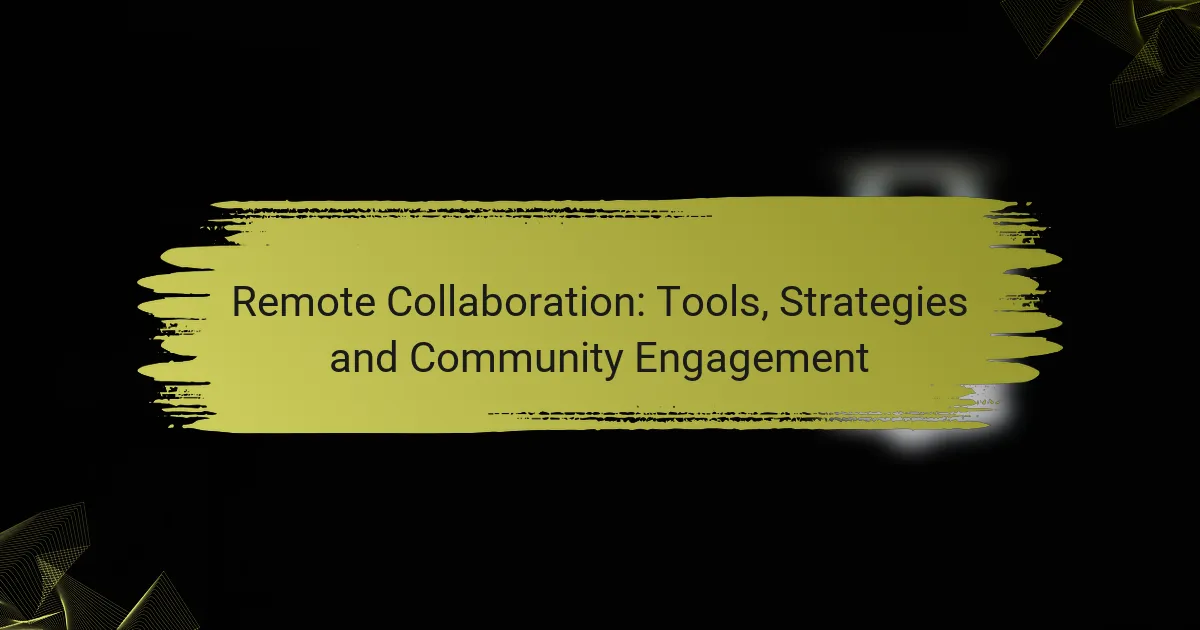In today’s digital landscape, effective remote collaboration is essential for teams to thrive across distances. By leveraging tools like Slack, Trello, and Zoom, organizations can enhance communication and streamline project management. Implementing structured communication and fostering connections through virtual activities further strengthens team engagement and cohesion, ensuring that all members remain aligned and productive.

What are the best remote collaboration tools?
The best remote collaboration tools enhance communication, streamline project management, and facilitate teamwork across distances. Popular options include Slack, Trello, Zoom, Asana, and Microsoft Teams, each serving distinct purposes to improve productivity and engagement.
Slack for team communication
Slack is a messaging platform designed for team communication, offering channels for organized discussions and direct messaging for quick exchanges. It supports integrations with various applications, allowing teams to centralize their workflow and reduce email clutter.
To maximize effectiveness, establish clear channel guidelines and encourage team members to use threads for specific topics. Avoid overwhelming notifications by customizing settings to prioritize important messages.
Trello for project management
Trello is a visual project management tool that uses boards, lists, and cards to organize tasks and track progress. Teams can create boards for different projects, add cards for tasks, and move them through stages such as “To Do,” “In Progress,” and “Done.”
Utilize labels, due dates, and checklists within cards to enhance clarity and accountability. Regularly review boards in team meetings to ensure everyone is aligned on priorities and deadlines.
Zoom for video conferencing
Zoom is a widely used video conferencing tool that enables virtual meetings, webinars, and screen sharing. It supports high-quality video and audio, making it suitable for both small team huddles and large presentations.
To ensure smooth meetings, familiarize yourself with Zoom’s features like breakout rooms and recording options. Always test your equipment beforehand and encourage participants to join with their cameras on for better engagement.
Asana for task tracking
Asana is a task management tool that helps teams track work and manage projects efficiently. Users can create tasks, assign them to team members, set deadlines, and monitor progress through various views like lists or timelines.
To get the most out of Asana, break larger projects into smaller tasks and set clear priorities. Regularly update task statuses and hold check-ins to keep everyone informed and accountable.
Microsoft Teams for integrated collaboration
Microsoft Teams combines chat, video conferencing, and file sharing into a single platform, making it ideal for integrated collaboration. It allows users to create teams for different projects, facilitating seamless communication and document collaboration.
Leverage Teams’ integration with other Microsoft 365 applications to enhance productivity. Encourage team members to utilize the planner feature for task assignments and to keep all project-related discussions within the platform to maintain focus.

How can remote teams improve collaboration?
Remote teams can enhance collaboration by implementing structured communication, utilizing shared tools, and maintaining regular updates. These strategies help ensure that team members stay aligned, informed, and engaged, regardless of their physical locations.
Establish clear communication protocols
Clear communication protocols are essential for remote teams to function effectively. This includes defining preferred communication channels, such as email, instant messaging, or video calls, and setting guidelines for response times. For example, teams might agree that emails should be answered within 24 hours, while instant messages require quicker responses.
Additionally, using a shared communication platform can streamline interactions. Tools like Slack or Microsoft Teams allow for organized discussions and easy access to past conversations, reducing misunderstandings and improving overall efficiency.
Utilize collaborative document editing
Collaborative document editing tools enable multiple team members to work on the same document simultaneously, enhancing productivity and creativity. Platforms like Google Docs or Microsoft Office 365 allow for real-time editing and commenting, which fosters immediate feedback and reduces the need for lengthy email exchanges.
When using these tools, it’s beneficial to establish version control practices to avoid confusion. For instance, teams can create a naming convention for document versions or utilize built-in version history features to track changes over time.
Set regular check-ins and updates
Regular check-ins and updates are crucial for maintaining team cohesion and accountability. Scheduling weekly or bi-weekly meetings allows team members to discuss progress, address challenges, and share insights. These meetings can be brief, lasting around 30 minutes to an hour, depending on the team’s needs.
In addition to formal meetings, informal check-ins can help strengthen relationships. Encourage team members to connect casually through virtual coffee breaks or team-building activities, which can boost morale and foster a sense of community within the remote team.

What strategies enhance remote team engagement?
Effective strategies for enhancing remote team engagement include fostering connections through virtual activities, maintaining open lines of communication for feedback, and recognizing team members’ contributions. These approaches help build a cohesive team culture, even when members are physically apart.
Implement virtual team-building activities
Virtual team-building activities are essential for creating camaraderie among remote team members. Consider activities like online trivia, virtual escape rooms, or collaborative games that encourage teamwork and problem-solving.
Scheduling these activities regularly, perhaps monthly or quarterly, can help maintain engagement. Ensure participation is voluntary to avoid burnout, and consider time zones when planning events to accommodate all team members.
Encourage open feedback channels
Creating open feedback channels allows team members to express their thoughts and concerns freely. Utilize tools like anonymous surveys or dedicated chat channels to facilitate honest communication without fear of repercussions.
Regularly solicit feedback on team processes and individual experiences. This practice not only improves team dynamics but also empowers employees, making them feel valued and heard.
Recognize and celebrate achievements
Recognizing and celebrating achievements is crucial for maintaining motivation in remote teams. Acknowledge both individual and team successes through shout-outs in meetings, newsletters, or dedicated channels.
Consider implementing a rewards system, such as gift cards or extra time off, to further incentivize outstanding performance. Celebrating milestones, whether big or small, fosters a positive atmosphere and encourages continued effort among team members.

What are the challenges of remote collaboration?
Remote collaboration presents several challenges that can hinder productivity and team cohesion. Key issues include time zone differences, technology limitations, and feelings of isolation among team members.
Time zone differences
Time zone differences can complicate scheduling meetings and coordinating tasks among team members located in various regions. For instance, a team spread across Europe and North America may find it difficult to find overlapping working hours, leading to delays in communication and decision-making.
To mitigate these challenges, consider using scheduling tools that display multiple time zones, allowing team members to see the best times for collaboration. Establishing a core set of hours where everyone is available can also help streamline interactions.
Technology limitations
Technology limitations can hinder effective remote collaboration, especially if team members lack access to reliable internet connections or necessary software tools. Issues such as poor video quality or unstable connections can disrupt meetings and reduce engagement.
To address these limitations, ensure that all team members have access to essential collaboration tools and provide training on their use. Regularly assess the technology stack to identify any gaps and invest in upgrades as needed to enhance the remote working experience.
Isolation and lack of social interaction
Isolation and lack of social interaction are common challenges in remote work environments, potentially leading to decreased morale and productivity. Team members may feel disconnected from their colleagues, which can affect collaboration and innovation.
To combat feelings of isolation, encourage regular informal check-ins and virtual social events. Creating opportunities for team bonding, such as online games or coffee breaks, can foster a sense of community and improve overall team dynamics.

How to choose the right remote collaboration tools?
Choosing the right remote collaboration tools involves understanding your team’s specific needs, the tools’ capabilities, and how well they integrate into your existing workflows. Prioritize features that enhance communication, project management, and file sharing while ensuring ease of use for all team members.
Assess team size and needs
Start by evaluating your team’s size and specific requirements. Smaller teams may benefit from simpler tools that facilitate direct communication, while larger teams might need more robust platforms that support project management and collaboration across multiple departments.
Consider the nature of your projects as well. If your work involves frequent file sharing and real-time collaboration, look for tools that excel in these areas. For example, tools like Slack or Microsoft Teams are great for communication, while Asana or Trello are better suited for project management.
Evaluate integration capabilities
Integration capabilities are crucial for ensuring that your collaboration tools work seamlessly with other software your team uses. Check if the tools can connect with your existing applications, such as email clients, calendar systems, or document storage services.
For instance, if your team relies heavily on Google Workspace, choose tools that integrate well with Google Drive, Google Calendar, and Gmail. This will streamline workflows and reduce the time spent switching between applications.
Consider user experience and support
User experience can significantly impact how effectively your team adopts and utilizes collaboration tools. Look for platforms that offer intuitive interfaces and easy navigation to minimize the learning curve for team members.
Additionally, consider the level of customer support available. Reliable support can help resolve issues quickly and keep your team productive. Check for resources like tutorials, FAQs, and live chat options to ensure assistance is readily available when needed.

What are effective remote work policies?
Effective remote work policies establish clear guidelines that help teams collaborate efficiently from different locations. These policies should address work hours, communication expectations, and performance metrics to ensure productivity and accountability.
Define work hours and availability
Clearly defining work hours and availability is crucial for remote teams to synchronize their efforts. Establish a standard time frame during which all team members are expected to be online, typically aligning with core business hours in the relevant time zone.
Consider using tools like shared calendars to indicate availability and schedule meetings. For example, if your team operates in Central European Time (CET), you might set core hours from 9 AM to 5 PM CET, allowing for flexibility outside these times.
Encourage team members to communicate their availability and any changes promptly. This can help avoid misunderstandings and ensure that everyone is on the same page regarding when they can collaborate or respond to inquiries.



